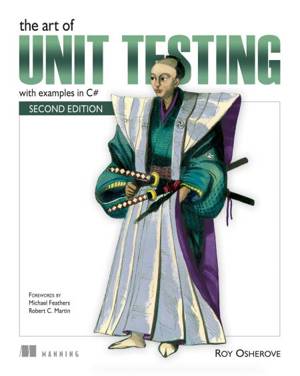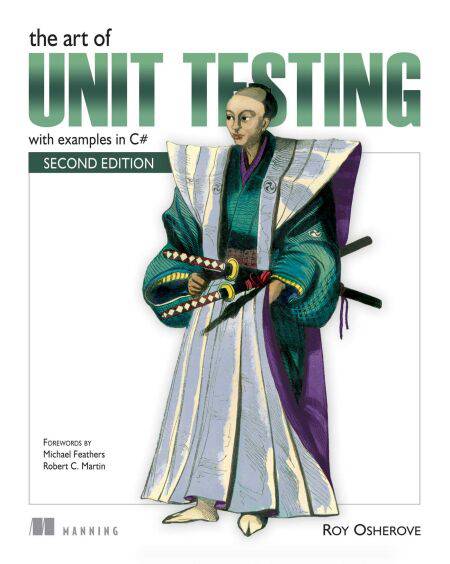
En raison d'une grêve chez bpost, votre commande pourrait être retardée. Vous avez besoin d’un livre rapidement ? Nos magasins vous accueillent à bras ouverts !
- Retrait gratuit dans votre magasin Club
- 7.000.000 titres dans notre catalogue
- Payer en toute sécurité
- Toujours un magasin près de chez vous
En raison de la grêve chez bpost, votre commande pourrait être retardée. Vous avez besoin d’un livre rapidement ? Nos magasins vous accueillent à bras ouverts !
- Retrait gratuit dans votre magasin Club
- 7.000.0000 titres dans notre catalogue
- Payer en toute sécurité
- Toujours un magasin près de chez vous
39,13 €
+ 39 points
Format
Description
Summary
The Art of Unit Testing, Second Edition guides you step by step from writing your first simple tests to developing robust test sets that are maintainable, readable, and trustworthy. You'll master the foundational ideas and quickly move to high-value subjects like mocks, stubs, and isolation, including frameworks such as Moq, FakeItEasy, and Typemock Isolator. You'll explore test patterns and organization, working with legacy code, and even "untestable" code. Along the way, you'll learn about integration testing and techniques and tools for testing databases and other technologies.
About this Book
You know you should be unit testing, so why aren't you doing it? If you're new to unit testing, if you find unit testing tedious, or if you're just not getting enough payoff for the effort you put into it, keep reading.
The Art of Unit Testing, Second Edition guides you step by step from writing your first simple unit tests to building complete test sets that are maintainable, readable, and trustworthy. You'll move quickly to more complicated subjects like mocks and stubs, while learning to use isolation (mocking) frameworks like Moq, FakeItEasy, and Typemock Isolator. You'll explore test patterns and organization, refactor code applications, and learn how to test "untestable" code. Along the way, you'll learn about integration testing and techniques for testing with databases.
The examples in the book use C#, but will benefit anyone using a statically typed language such as Java or C++.
Purchase of the print book includes a free eBook in PDF, Kindle, and ePub formats from Manning Publications.
What's Inside
Create readable, maintainable, trustworthy tests Fakes, stubs, mock objects, and isolation (mocking) frameworks Simple dependency injection techniques Refactoring legacy code
About the Author
Roy Osherove has been coding for over 15 years, and he consults and trains teams worldwide on the gentle art of unit testing and test-driven development. His blog is at ArtOfUnitTesting.com.
Table of Contents
PART 1 GETTING STARTED The basics of unit testing A first unit test PART 2 CORE TECHNIQUES Using stubs to break dependencies Interaction testing using mock objects Isolation (mocking) frameworks Digging deeper into isolation frameworks PART 3 THE TEST CODE Test hierarchies and organization The pillars of good unit tests PART 4 DESIGN AND PROCESS Integrating unit testing into the organization Working with legacy code Design and testability
The Art of Unit Testing, Second Edition guides you step by step from writing your first simple tests to developing robust test sets that are maintainable, readable, and trustworthy. You'll master the foundational ideas and quickly move to high-value subjects like mocks, stubs, and isolation, including frameworks such as Moq, FakeItEasy, and Typemock Isolator. You'll explore test patterns and organization, working with legacy code, and even "untestable" code. Along the way, you'll learn about integration testing and techniques and tools for testing databases and other technologies.
About this Book
You know you should be unit testing, so why aren't you doing it? If you're new to unit testing, if you find unit testing tedious, or if you're just not getting enough payoff for the effort you put into it, keep reading.
The Art of Unit Testing, Second Edition guides you step by step from writing your first simple unit tests to building complete test sets that are maintainable, readable, and trustworthy. You'll move quickly to more complicated subjects like mocks and stubs, while learning to use isolation (mocking) frameworks like Moq, FakeItEasy, and Typemock Isolator. You'll explore test patterns and organization, refactor code applications, and learn how to test "untestable" code. Along the way, you'll learn about integration testing and techniques for testing with databases.
The examples in the book use C#, but will benefit anyone using a statically typed language such as Java or C++.
Purchase of the print book includes a free eBook in PDF, Kindle, and ePub formats from Manning Publications.
What's Inside
Create readable, maintainable, trustworthy tests Fakes, stubs, mock objects, and isolation (mocking) frameworks Simple dependency injection techniques Refactoring legacy code
About the Author
Roy Osherove has been coding for over 15 years, and he consults and trains teams worldwide on the gentle art of unit testing and test-driven development. His blog is at ArtOfUnitTesting.com.
Table of Contents
PART 1 GETTING STARTED The basics of unit testing A first unit test PART 2 CORE TECHNIQUES Using stubs to break dependencies Interaction testing using mock objects Isolation (mocking) frameworks Digging deeper into isolation frameworks PART 3 THE TEST CODE Test hierarchies and organization The pillars of good unit tests PART 4 DESIGN AND PROCESS Integrating unit testing into the organization Working with legacy code Design and testability
Spécifications
Parties prenantes
- Auteur(s) :
- Editeur:
Contenu
- Nombre de pages :
- 292
- Langue:
- Anglais
Caractéristiques
- EAN:
- 9781638353058
- Date de parution :
- 23-11-13
- Format:
- Ebook
- Protection digitale:
- Adobe DRM
- Format numérique:
- ePub

Les avis
Nous publions uniquement les avis qui respectent les conditions requises. Consultez nos conditions pour les avis.






